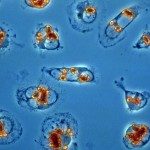Lien vers Pubmed [PMID] – 9218448
J Biol Chem 1997 Jul; 272(29): 18140-6
Membrane potential generation via malate/lactate exchange catalyzed by the malate carrier (MleP) of Lactococcus lactis, together with the generation of a pH gradient via decarboxylation of malate to lactate in the cytoplasm, is a typical example of a secondary proton motive force-generating system. The mleP gene was cloned, sequenced, and expressed in a malolactic fermentation-deficient L. lactis strain. Functional analysis revealed the same properties as observed in membrane vesicles of a malolactic fermentation-positive strain. MleP belongs to a family of secondary transporters in which the citrate carriers from Leuconostoc mesenteroides (CitP) and Klebsiella pneumoniae (CitS) are found also. CitP, but not CitS, is also involved in membrane potential generation via electrogenic citrate/lactate exchange. MleP, CitP, and CitS were analyzed for their substrate specificity. The 2-hydroxycarboxylate motif R1R2COHCOOH, common to the physiological substrates, was found to be essential for transport although some 2-oxocarboxylates could be transported to a lesser extent. Clear differences in substrate specificity among the transporters were observed because of different tolerances toward the R substituents at the C2 atom. Both MleP and CitP transport a broad range of 2-hydroxycarboxylates with R substituents ranging in size from two hydrogen atoms (glycolate) to acetyl and methyl groups (citromalate) for MleP and two acetyl groups (citrate) for CitP. CitS was much less tolerant and transported only citrate and at a low rate citromalate. The substrate specificities are discussed in the context of the physiological function of the transporters.


